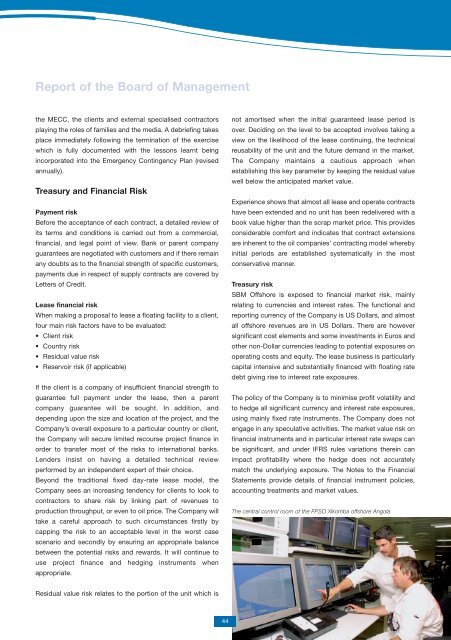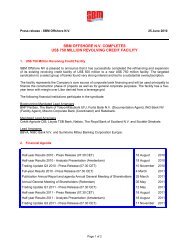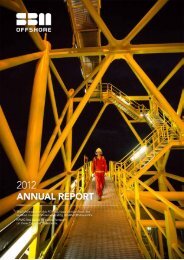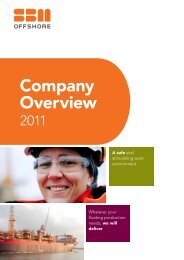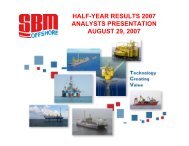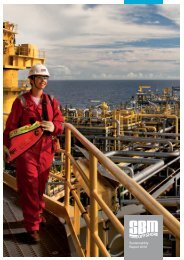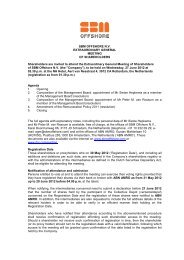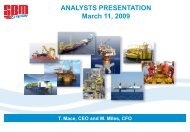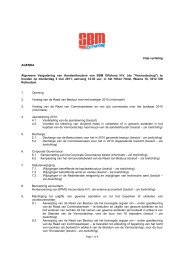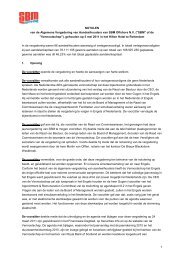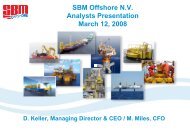2005 Annual Report - SBM Offshore
2005 Annual Report - SBM Offshore
2005 Annual Report - SBM Offshore
You also want an ePaper? Increase the reach of your titles
YUMPU automatically turns print PDFs into web optimized ePapers that Google loves.
<strong>Report</strong> of the Board of Management<br />
the MECC, the clients and external specialised contractors<br />
playing the roles of families and the media. A debriefing takes<br />
place immediately following the termination of the exercise<br />
which is fully documented with the lessons learnt being<br />
incorporated into the Emergency Contingency Plan (revised<br />
annually).<br />
Treasury and Financial Risk<br />
Payment risk<br />
Before the acceptance of each contract, a detailed review of<br />
its terms and conditions is carried out from a commercial,<br />
financial, and legal point of view. Bank or parent company<br />
guarantees are negotiated with customers and if there remain<br />
any doubts as to the financial strength of specific customers,<br />
payments due in respect of supply contracts are covered by<br />
Letters of Credit.<br />
Lease financial risk<br />
When making a proposal to lease a floating facility to a client,<br />
four main risk factors have to be evaluated:<br />
• Client risk<br />
• Country risk<br />
• Residual value risk<br />
• Reservoir risk (if applicable)<br />
If the client is a company of insufficient financial strength to<br />
guarantee full payment under the lease, then a parent<br />
company guarantee will be sought. In addition, and<br />
depending upon the size and location of the project, and the<br />
Company’s overall exposure to a particular country or client,<br />
the Company will secure limited recourse project finance in<br />
order to transfer most of the risks to international banks.<br />
Lenders insist on having a detailed technical review<br />
performed by an independent expert of their choice.<br />
Beyond the traditional fixed day-rate lease model, the<br />
Company sees an increasing tendency for clients to look to<br />
contractors to share risk by linking part of revenues to<br />
production throughput, or even to oil price. The Company will<br />
take a careful approach to such circumstances firstly by<br />
capping the risk to an acceptable level in the worst case<br />
scenario and secondly by ensuring an appropriate balance<br />
between the potential risks and rewards. It will continue to<br />
use project finance and hedging instruments when<br />
appropriate.<br />
Residual value risk relates to the portion of the unit which is<br />
44<br />
not amortised when the initial guaranteed lease period is<br />
over. Deciding on the level to be accepted involves taking a<br />
view on the likelihood of the lease continuing, the technical<br />
reusability of the unit and the future demand in the market.<br />
The Company maintains a cautious approach when<br />
establishing this key parameter by keeping the residual value<br />
well below the anticipated market value.<br />
Experience shows that almost all lease and operate contracts<br />
have been extended and no unit has been redelivered with a<br />
book value higher than the scrap market price. This provides<br />
considerable comfort and indicates that contract extensions<br />
are inherent to the oil companies’ contracting model whereby<br />
initial periods are established systematically in the most<br />
conservative manner.<br />
Treasury risk<br />
<strong>SBM</strong> <strong>Offshore</strong> is exposed to financial market risk, mainly<br />
relating to currencies and interest rates. The functional and<br />
reporting currency of the Company is US Dollars, and almost<br />
all offshore revenues are in US Dollars. There are however<br />
significant cost elements and some investments in Euros and<br />
other non-Dollar currencies leading to potential exposures on<br />
operating costs and equity. The lease business is particularly<br />
capital intensive and substantially financed with floating rate<br />
debt giving rise to interest rate exposures.<br />
The policy of the Company is to minimise profit volatility and<br />
to hedge all significant currency and interest rate exposures,<br />
using mainly fixed rate instruments. The Company does not<br />
engage in any speculative activities. The market value risk on<br />
financial instruments and in particular interest rate swaps can<br />
be significant, and under IFRS rules variations therein can<br />
impact profitability where the hedge does not accurately<br />
match the underlying exposure. The Notes to the Financial<br />
Statements provide details of financial instrument policies,<br />
accounting treatments and market values.<br />
The central control room of the FPSO Xikomba offshore Angola


